The following material was originally contained in the Jefferson County School News Vol. 2, No. 5 dated February 1976 and graciously provided by its Editor, Mary Stocks.
In 1976 Jefferson County School News was a monthly publication sponsored by the Board of Education as a public service to Jefferson County residents.
Superintendent - Harold L. Pickens
President of the Board - Richard Neal
Editor - Mary Stocks
Special thanks to the following people who so willingly supplied information to the editor of this paper for this special publication.
T. A. Lowery, Lewis Nichols, Betty Kidwiler, Edith Bragg, Mrs. W.P. Fleming, Mrs. Brian Houser, Mrs. Lester Moler, Mrs. William Hoak, Mrs Mae Ramey, 0scar Jones
The information used in this issue of SCHOOL NEWS is based on the Harpers Ferry District Board of Education minutes 1889-1933. In 1933 the county unit system was established in West Virginia. The district boards of education were abolished, and a five man county board of education was established
Jefferson County Public Schools
Harpers Ferry District School History
1889-1933
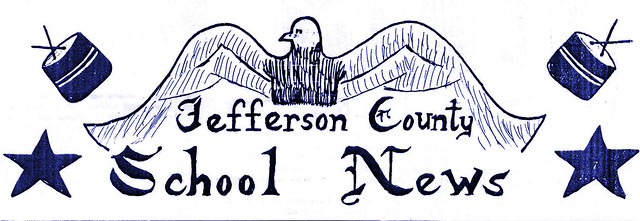
Prior to 1889
0n June 3, 1847, Jefferson County citizens voted to establish a district free school system. One year later, 23 schools with an enrollment of 1,100 were active. Thirteen of these schools were new buildings. Jefferson County was at this time still a county of Virginia.
After the outbreak of the Civil War in 1861, a movement began to establish the state of West Virginia. The writing of the constitution started at Wheeling on November 26, 1861, and the document was ratified on June 20, 1863.
In December of I863, the West Virginia Legislature passed an act establishing a free school system under the new constitution, with one of its provisions calling for a county school superintendent for each county.
Samuel Strider was elected in 1865 as Jefferson County's first superintendent. However, he had little authority over the five school districts: Harpers Ferry, Shepherdstown, Charles Town, Kabletown and Middleway.
The superintendent was the financial secretary for the district boards, visited schools, gave examinations for teacher certificates and made reports to the State Superintendent of schools.
Each of the five school districts had its own board of education which had sole authority over the schools within the districts.
First Written Accounts Harpers Ferry District Begin 1889
Many free public schools were established in the Harpers Ferry District after the June 3, 1847 act was passed by Jefferson County voters.
However, the first written accounts of actions taken by the Harpers Ferry District Board of Education begin for the year 1889.
According to the Board of Education minutes for July 10, 1889, the Harpers Ferry District included seven sub districts each with an appointed trustee to supervise the school(s) in the sub districts.
The following sub districts and schools were active in 1889:
District 1-Bakerton
Oak Grove School
District 2-Halltown
Halltown School (White)
Halltown School (Black)
District 3-Bo1ivar
Bolivar School (Black)
Bolivar School (White)
District 4-Harpers Ferry
Camp Hill School
District 5-Pipertown
Silver Grove School
District 6-Engle
Elk Run School
District 7-Millville
Cedar Hill School
The 13 teachers employed for the 1889-1990 school term were paid $33 per month for No. 1 Certificates, $25 for No. 2 Certificates, and $18 for No. 3 Certificates.
The Board made the following levy to cover expenses for the 1889-1890 school year: 15 cents on each one hundred dollars valuation of property within the District for the Teachers Fund; a special 3 and a half cents on each one hundred dollars valuation for the Teachers Fund; and 22 cents on each one hundred dollars valuation for the Building Fund.
CAMP HILL SCHOOL BUILT 1889
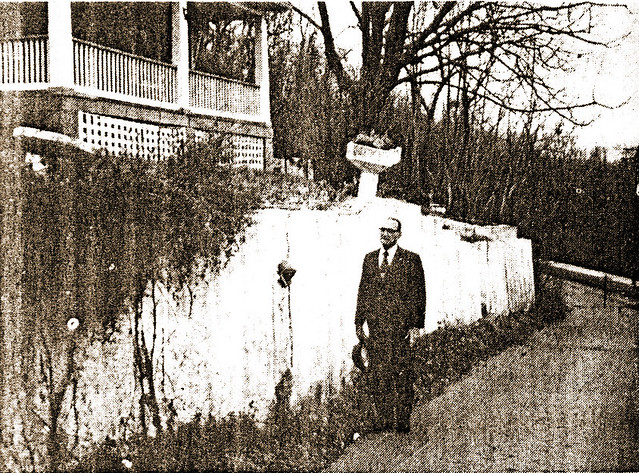
Lewis Nichols, a life-long resident of Harpers Ferry, is pictured standing in front of the home which is located on the former site of the Camp Hill Graded School built in 1889 for white children of Harpers Ferry. Probably a church stood on the location before Camp Hill was built since the Board of Education minutes refer to "selling stone from the old church" on the Camp Hill site.
Mr. Nichols attended Camp Hill from 1902-1910 graduating with an eighth grade certificate. He later graduated from high school after the Harpers Ferry High School was built in l912.
The home pictured is the residence of Loretta Quick. It is located on Church Street although once the location was described as "The Bend" on High Street.
Camp Hill was evidently a two floor structure because the board minutes of 1889 instruct the building committee to have "four iron columns placed in the middle of the new school building as support to the upper floors."
The Board had intended to rent the upstairs of the Camp Hill School for public exhibitions but found that it was "unlawful to rent any portion of a school for dancing or public exhibitions".
BOLIVAR GRADED WHITE SCHOOL
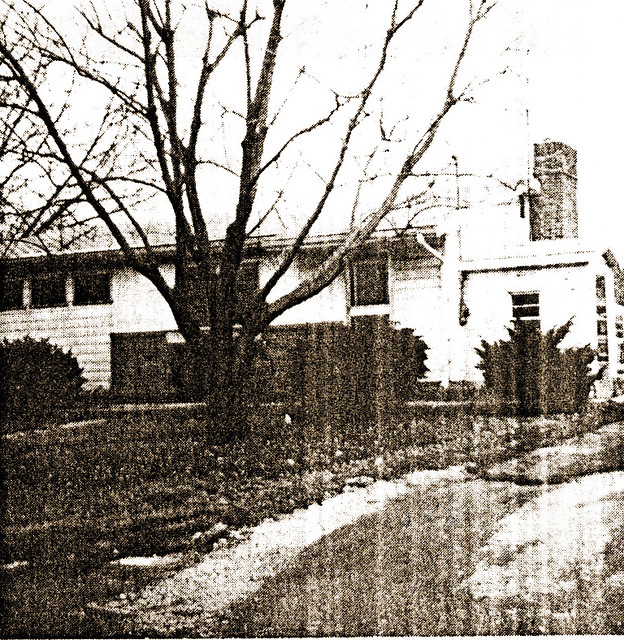
The home pictured, located on Gilbert Street in Bolivar, was formerly the site of the Bolivar Graded School built in 1898. There were at least two other Bolivar public white schools that existed at different times before 1898, but the exact location of these schools is not known.
The school built in 1898 cost $2,112 and was evidently quite large since the Board minutes of 1899 record the purchase of 60 new desks "to be used in connection with old ones" for the Bolivar School.
The school in use before the 1898 school must also have been large because the Bolivar School was the only one in the district to have three teachers, according to the minutes of 1889.
An interesting account of the dismissal of a principal from the earlier Bolivar School is recorded in the minutes cf 1893. The principal was dismissed because Board members had visited the school and found that "students would voluntarily leave their seats and walk about the room wholly ignoring the presence of the principal . General conversation was permitted and the school was unusually noisy."
Early in the 1890's, the schools of Harpers Ferry and Bolivar were closed for a while due to the spread of a contagious disease. The physicians of the area asked that the Board close the schools until the disease was abated. According to the minutes the school s were closed and ordered "to be disinfected, whitewashed, and scrubbed thoroughly and that the privies be cleaned and limed."
After the erection of the Harpers Ferry Graded and High School (Washington Street), students from the 1898 Bolivar School were transferred there. In 1915, the Bolivar School was sold to Fred Mauzy for $750 and was turned into a private residence.
In 1949 the property was bought by Vernon Tomlin but the school was destroyed by fire around 1960. The home pictured was built on the former school site by Tomlin, its present occupant.
BOLIVAR GRADED BLACK SCHOOL

The home pictured is the residence of Mrs. Elmira Dennis, Ridge Street, Bolivar, but it was at one time the two-room Bolivar Graded School for black students of Bolivar and Harpers Ferry. The school was evidently built prior to 1889 since it is mentioned in the 1889 Harpers Ferry District Board of Education minutes.
By 1926 the enrollment of the school had outgrown the two-room structure. The basement of the Zion Baptist Church, also on Ridge Street, was rented by the Harpers Ferry District Board for $10 per month for extra classroom space.
The Bolivar School on Ridge Street was used continuously until 1930 when it was replaced with the Grandview School. The Ridge Street School was sold in 1931 to B. M. Dennis for $350.
Church Basement Rented as School
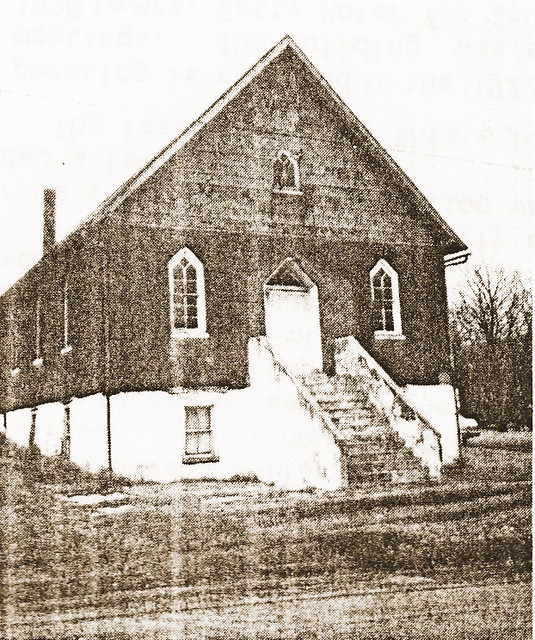
The Zion Baptist Church on Ridge Street in Bolivar was built in l894. In 1926 the Harpers Ferry District Board of Education rented the basement of the church for $10 per month for extra classroom space for the overcrowded Ridge Street Bolivar Graded School.
GRANDVIEW SCHOOL
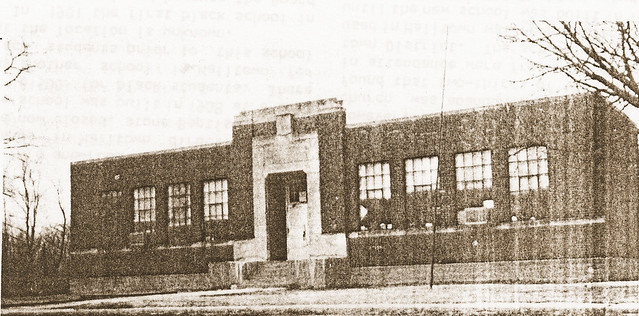
Pictured is the Grandview School built in 1930 to replace the Ridge Street Bolivar Graded School. The four room school served black students of the Harpers Ferry and Bolivar area for grades 1-8. After schools were integrated, it was used for a time for area students in the fifth and sixth grades. The school is still the property of the Jefferson County Board of Education and is rented by the National Park Service
HARPERS FERRY HIGH 1912
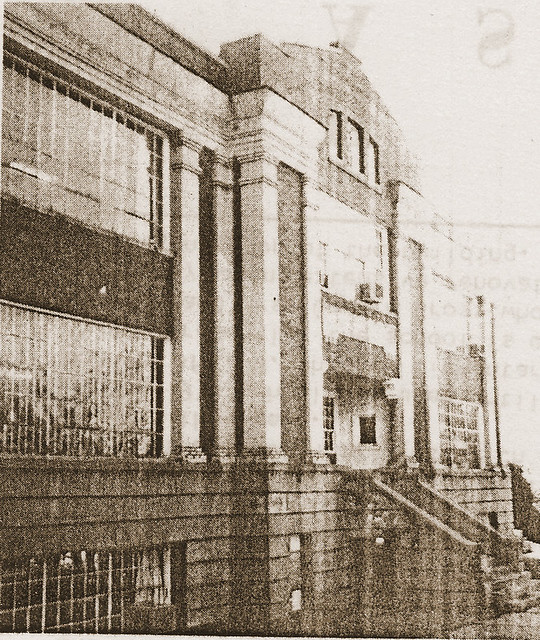
This school building was erected in 1912 on Washington Street in Harpers Ferry, It was called Harpers Ferry High School although it was used both as a high school and a graded school.
In 1909 a petition from a large group of citizens from the Harpers Ferry District was presented to the Board of Education asking that a centrally located graded school be built between Harpers Ferry and Bolivar for white students. A special election held in 1910 resulted in 454 votes for the new school and 48 against.
However, changes in the state law which came soon after the 1910 election raised some doubt about the legality of the election. On November 5, 1912, a second election was held, and again the voters overwhelmingly approved the building of a new school.
The same year a low bid of $26,993 was accepted for the construction of school which came to be called Harpers Ferry High School although it was both as a high school and graded school.
In the first few years of its existence, Harpers Ferry High School had two principals, one for the high school level and one for the graded school level. In 1913, the opening year of the school, one principal and five teachers were employed for grades 1-6, and one principal and one assistant for the higher grades.
By 1915 a manual training department was added to the high school curriculum, and the expenditure of $25 was approved by the Board to purchase the necessary tools.
The auditorium of the high school seemed to be a popular meeting place for community groups although the Board charged $4 for the use of the building. In 1920, however, the Board declared that the auditorium would not be used for political meetings.
At about the same time, a complaint against the high school from Catholic parents was brought to the Board's attention. The parents disagreed with the school's policy of compulsory attendance at morning chapel services. The Board declared that "all children attending school must attend chapel in the auditorium or be sent home.''
In 1919, a state supervisor of schools visited the high school and later sent a written evaluation. The evaluation stated that the Principal had too many classes to teach, leaving him too little time to supervise other teachers; that chemistry should be added to the curriculum; and that a way to encourage more area students to continue high school after eighth grade should be sought. In 1924, Harpers Ferry High received a first class classification from that same supervisor.
The teaching of instrumental music must have been added to the high school's curriculum in 1920 since a special board meeting was held in that year to decide whether to begin music instruction on a six month trial basis. Two board members voted for the trial period and one against. In 1927 a vocational agriculture teacher was added to the staff with the state paying one third of his salary.
The school was used for both a graded school and high school until 1930 when a new Harpers Ferry High School was built In 1930 the school was named Harpers Ferry Graded School, and in 1968 it was changed to C.W. Shipley Elementary in honor of Charles Waldron Shipley who served as principal for many years.
The school was used until 1971 when it was replaced with the new C.W. Shipley Elementary located one half mile west of Harpers Ferry on US Rt 340 East. The school is still the property of the Board of Education and is rented by the National Park Service.
HARPERS FERRY HIGH - 1930

A new Harpers Ferry High School was built in 1930 as the result of a $112,500 bond levy approved in 1929 by Harpers Ferry District citizens. The levy also provided a new school in Millville and the Grand View School in Bolivar.
However, if another bond levy which has been proposed in 1928 had passed, a new high school for Harpers Ferry students would have been in a very different location.
The Boards of Education of the Charles Town District and the Harpers Ferry District met in a joint session in 1928 and proposed the building of a high school to serve both districts. The school was to be located near Charles Town, and the cost of acquiring the site and building the school was not to exceed $160,000. in November 1928, election results showed the citizens of Harpers Ferry strongly opposed to the consolidated high school concept. There were 333 votes in favor and 803 against the joint venture.
The new high school was used for grades 7 - 12 until 1971 when a new county high school was opened. Presently the school is Harpers Ferry Junior High serving grades 7-9.
Millville Schools
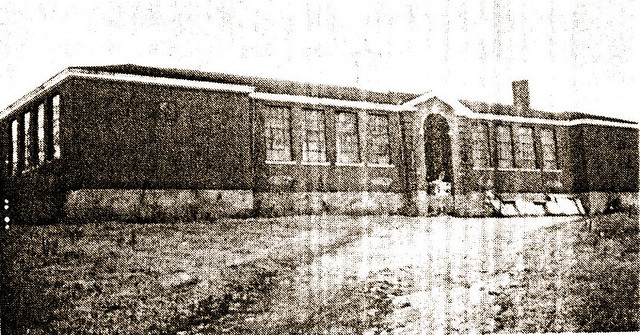
Pictured is the Millville Graded School which was built in 1930 after the approval of a bond levy which also provided the new Harpers Ferry High and Grandview Elementary.
This six-room school replaced an earlier school, no longer standing, which was located nearby. The earlier school , called Cedar Hill , was built sometime prior to 1889 since the school is mentioned in the earliest available Board of Education minutes which date back to that year.
The 1930 school was used until the opening of C. W. Shipley Elementary in 1971. Presently the school is owned by Mr. and Mrs. Gerald Gross who are currently making extensive renovations to the interior of the building.
Halltown Schools
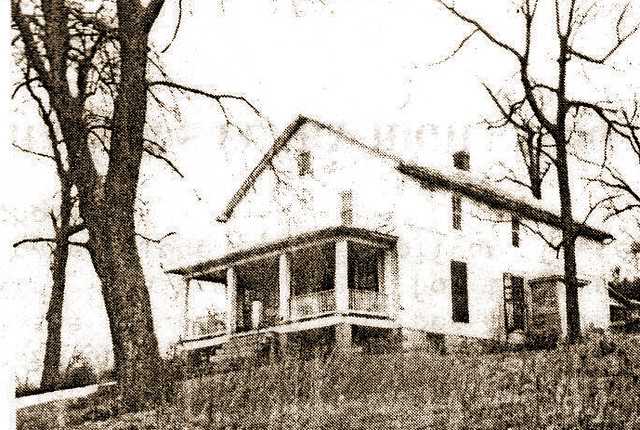
Pictured is the Halltown school for white students built in 1896 According to the Board minutes of February 10, 1896, the President of the Board Richard Henderson, "advanced the Board one thousand dollars to rebuild the Halltown school house, the Board to pay interest on same'" The word "rebuild" seems to imply that the school used before 1896 might have been part of or on the same location as the school built in 1896.
The building was originally a one room structure but a partition was added a few years later.
The last mention of this school operating is recorded in the 1922 Board meetings. The building was sold in 1928 to Mrs. Betty Moler for $505. Apparently white students from the Halltown area were transported to what was then Harpers Ferry High School (Washington Street) after 1922.
Today the building is used as a private residence.
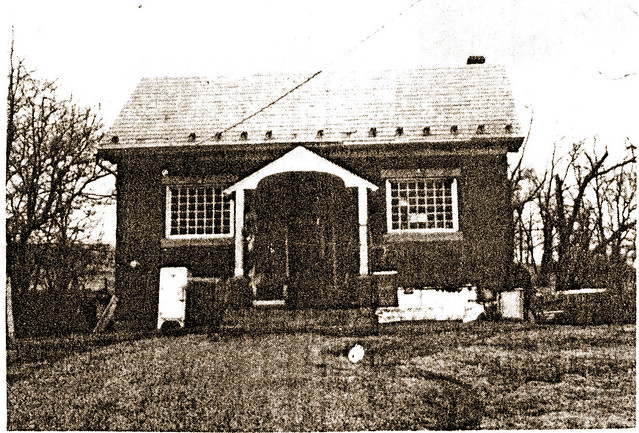
This one-room brick school still stands in Halltown directly behind the now closed, stone Baptist Church. The school was built in 1908 at a cost of $1500 for black students. There was another school in Halltown for black students prior to this school but the location is unknown.
In 1901 the first black school in Halltown was closed because the Board felt that a black school was needed more midway between Halltown and Engle.
Thus in 1901 classes began in the basement of a black church somewhere in the vicinity of Deck's Crossroads. However, in 1901, the school in the church was abandoned when the Board found that two-thirds of the students in attendance were from the Shepherdstown District. The school previously used in Halltown was reopened and used until the new school was built in 1908. The Halltown School for black students remained open until 1930 when students from the area were transferred to the new Grandview School in Bolivar.
Silver Grove School
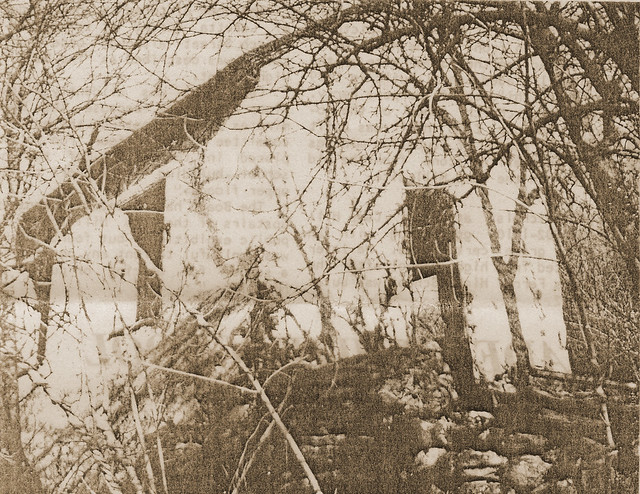
The Silver Grove School, built sometime prior to 1889, still stands today in Pipertown on Hostler Road. The one-room school served students in grades 1-8 and did not close its doors until 1940. One interesting item of business concerning Silver Grove was handled by the Harpers Ferry District Board of Education in 1920, The parents of students of Silver Grove wrote a letter to the Board protesting the employment of a Catholic teacher on the grounds that the teacher "might not read the Bible and have the Lord's prayer in the morning exercises." The Board refused to dismiss the teacher, but she resigned at the end of the school year.
Chestnut Hill School
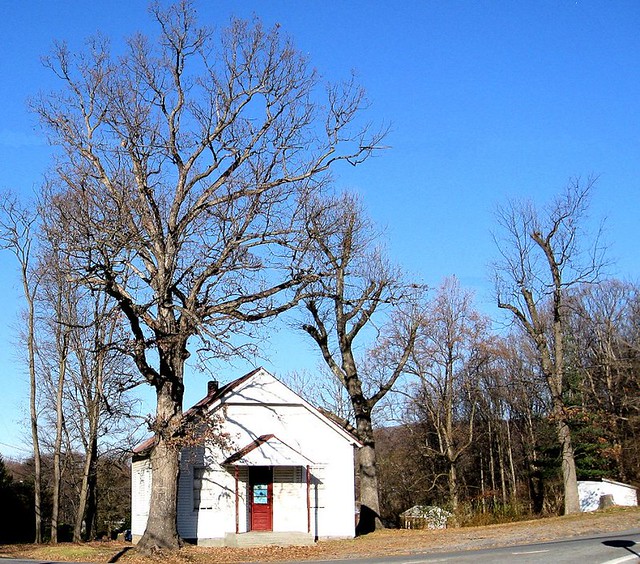
The Chestnut Hill School was built on what was then called Bithias Green in 1899. The school, located on Hostler Road, still stands today. It was a one room school used continuously until it closed in 1940 when the Blue Ridge Elementary was erected. Today the school is the property of the Chestnut Hill Methodist Church located across the road from the old school.
BAKERTON SCHOOLS

The Oak Grove School was erected in Bakerton sometime prior to 1889. It was closed in 1917 and sold to Martin Welsh who tore down the school and used the materials to build his family home in Bakerton. Today on the same lot where Oak Grove once stood is a home presently used as headquarters for the Bakerton Ruritan Club. This sketch of the school was made by Marie Hoage, an employee of the Board of Education.
In 1917 a school for black children was opened in the basement of a church in Bakerton. It is unknown how long this church school operated.

The Elk Run School sketched above was erected in Engle sometime prior to 1889. The school continued to operate until 1930. At that time students of the area were transported to the Harpers Ferry Graded School (Washington Street). The school, no longer standing, was located directly across from Keller Chapel. The sketch was drawn by Marie Hoage from a post card loaned to the editor of this paper by Esther Bragg of Engle.
One interesting account of Board of Education actions concerning the Engle School is recorded in the July 31, 1889 minutes. The account reads:
Mr. Henderson (president of the Board) stated that he had heard a great deal of clamor about the railroad track being built by the Messrs. Bakers near Engle's Switch to his lime kilns, that they were encroaching upon the rights of the Board of Education by cutting off a corner of the school lot nearby - and thought it would be necessary if such was the case to investigate it - and see if it could be arranged with the Board of Education's rights.
There was also a school called the Keller Colored School which operated in Engle in the early 1900's. Neither the location of this school nor the dates of its operation are known.

Pictured is Bakerton Elementary which was built in 1921 to replace Oak Grove School. Prior to building the school, Board members visited the new four-room school which had been recently completed in Shenandoah Junction of the Charles Town District to get ideas for the new Bakerton School. Construction costs were $10,150.
Bakerton School closed in 1965 and students of the area were transported to what was then Harpers Ferry Graded School (Washington Street). Today this school is owned by Mr. and Mrs. Burnett Bragdon who are renovating the building for future occupancy.
Worth Noting:
Artist for SCHOOL NEWS
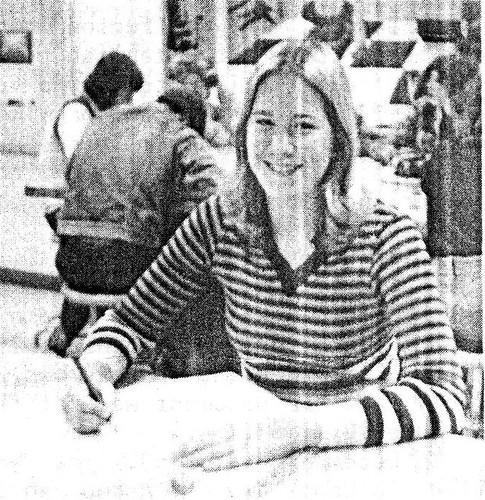
Kitty Thornton, Jefferson High senior designed the heading for this issue of SCHOOL NEWS.
She is the daughter of Frances and Clark Thornton of Shepherdstown
At Jefferson, Kitty especially enjoys playing on the tennis team.
After graduation, she plans to attend college to study some area of medicine.
Note from Shannondale and Beyond: We'd be delighted to update the images and information. It's nearly 35 years old (in 2010) and reflects its age in some cases. We certainly won't reject any offers of help, heading us in the right direction to take some present day photos and checking the information for errors and omissions.
We hope you've enjoyed the show
In 1976 Jefferson County School News was a monthly publication sponsored by the Board of Education as a public service to Jefferson County residents.
Superintendent - Harold L. Pickens
President of the Board - Richard Neal
Editor - Mary Stocks
Special thanks to the following people who so willingly supplied information to the editor of this paper for this special publication.
T. A. Lowery, Lewis Nichols, Betty Kidwiler, Edith Bragg, Mrs. W.P. Fleming, Mrs. Brian Houser, Mrs. Lester Moler, Mrs. William Hoak, Mrs Mae Ramey, 0scar Jones
The information used in this issue of SCHOOL NEWS is based on the Harpers Ferry District Board of Education minutes 1889-1933. In 1933 the county unit system was established in West Virginia. The district boards of education were abolished, and a five man county board of education was established
Jefferson County Public Schools
Harpers Ferry District School History
1889-1933

Prior to 1889
0n June 3, 1847, Jefferson County citizens voted to establish a district free school system. One year later, 23 schools with an enrollment of 1,100 were active. Thirteen of these schools were new buildings. Jefferson County was at this time still a county of Virginia.
After the outbreak of the Civil War in 1861, a movement began to establish the state of West Virginia. The writing of the constitution started at Wheeling on November 26, 1861, and the document was ratified on June 20, 1863.
In December of I863, the West Virginia Legislature passed an act establishing a free school system under the new constitution, with one of its provisions calling for a county school superintendent for each county.
Samuel Strider was elected in 1865 as Jefferson County's first superintendent. However, he had little authority over the five school districts: Harpers Ferry, Shepherdstown, Charles Town, Kabletown and Middleway.
The superintendent was the financial secretary for the district boards, visited schools, gave examinations for teacher certificates and made reports to the State Superintendent of schools.
Each of the five school districts had its own board of education which had sole authority over the schools within the districts.
First Written Accounts Harpers Ferry District Begin 1889
Many free public schools were established in the Harpers Ferry District after the June 3, 1847 act was passed by Jefferson County voters.
However, the first written accounts of actions taken by the Harpers Ferry District Board of Education begin for the year 1889.
According to the Board of Education minutes for July 10, 1889, the Harpers Ferry District included seven sub districts each with an appointed trustee to supervise the school(s) in the sub districts.
The following sub districts and schools were active in 1889:
District 1-Bakerton
Oak Grove School
District 2-Halltown
Halltown School (White)
Halltown School (Black)
District 3-Bo1ivar
Bolivar School (Black)
Bolivar School (White)
District 4-Harpers Ferry
Camp Hill School
District 5-Pipertown
Silver Grove School
District 6-Engle
Elk Run School
District 7-Millville
Cedar Hill School
The 13 teachers employed for the 1889-1990 school term were paid $33 per month for No. 1 Certificates, $25 for No. 2 Certificates, and $18 for No. 3 Certificates.
The Board made the following levy to cover expenses for the 1889-1890 school year: 15 cents on each one hundred dollars valuation of property within the District for the Teachers Fund; a special 3 and a half cents on each one hundred dollars valuation for the Teachers Fund; and 22 cents on each one hundred dollars valuation for the Building Fund.
CAMP HILL SCHOOL BUILT 1889

Lewis Nichols, a life-long resident of Harpers Ferry, is pictured standing in front of the home which is located on the former site of the Camp Hill Graded School built in 1889 for white children of Harpers Ferry. Probably a church stood on the location before Camp Hill was built since the Board of Education minutes refer to "selling stone from the old church" on the Camp Hill site.
Mr. Nichols attended Camp Hill from 1902-1910 graduating with an eighth grade certificate. He later graduated from high school after the Harpers Ferry High School was built in l912.
The home pictured is the residence of Loretta Quick. It is located on Church Street although once the location was described as "The Bend" on High Street.
Camp Hill was evidently a two floor structure because the board minutes of 1889 instruct the building committee to have "four iron columns placed in the middle of the new school building as support to the upper floors."
The Board had intended to rent the upstairs of the Camp Hill School for public exhibitions but found that it was "unlawful to rent any portion of a school for dancing or public exhibitions".
BOLIVAR GRADED WHITE SCHOOL

The home pictured, located on Gilbert Street in Bolivar, was formerly the site of the Bolivar Graded School built in 1898. There were at least two other Bolivar public white schools that existed at different times before 1898, but the exact location of these schools is not known.
The school built in 1898 cost $2,112 and was evidently quite large since the Board minutes of 1899 record the purchase of 60 new desks "to be used in connection with old ones" for the Bolivar School.
The school in use before the 1898 school must also have been large because the Bolivar School was the only one in the district to have three teachers, according to the minutes of 1889.
An interesting account of the dismissal of a principal from the earlier Bolivar School is recorded in the minutes cf 1893. The principal was dismissed because Board members had visited the school and found that "students would voluntarily leave their seats and walk about the room wholly ignoring the presence of the principal . General conversation was permitted and the school was unusually noisy."
Early in the 1890's, the schools of Harpers Ferry and Bolivar were closed for a while due to the spread of a contagious disease. The physicians of the area asked that the Board close the schools until the disease was abated. According to the minutes the school s were closed and ordered "to be disinfected, whitewashed, and scrubbed thoroughly and that the privies be cleaned and limed."
After the erection of the Harpers Ferry Graded and High School (Washington Street), students from the 1898 Bolivar School were transferred there. In 1915, the Bolivar School was sold to Fred Mauzy for $750 and was turned into a private residence.
In 1949 the property was bought by Vernon Tomlin but the school was destroyed by fire around 1960. The home pictured was built on the former school site by Tomlin, its present occupant.
BOLIVAR GRADED BLACK SCHOOL

The home pictured is the residence of Mrs. Elmira Dennis, Ridge Street, Bolivar, but it was at one time the two-room Bolivar Graded School for black students of Bolivar and Harpers Ferry. The school was evidently built prior to 1889 since it is mentioned in the 1889 Harpers Ferry District Board of Education minutes.
By 1926 the enrollment of the school had outgrown the two-room structure. The basement of the Zion Baptist Church, also on Ridge Street, was rented by the Harpers Ferry District Board for $10 per month for extra classroom space.
The Bolivar School on Ridge Street was used continuously until 1930 when it was replaced with the Grandview School. The Ridge Street School was sold in 1931 to B. M. Dennis for $350.
Church Basement Rented as School

The Zion Baptist Church on Ridge Street in Bolivar was built in l894. In 1926 the Harpers Ferry District Board of Education rented the basement of the church for $10 per month for extra classroom space for the overcrowded Ridge Street Bolivar Graded School.
GRANDVIEW SCHOOL

Pictured is the Grandview School built in 1930 to replace the Ridge Street Bolivar Graded School. The four room school served black students of the Harpers Ferry and Bolivar area for grades 1-8. After schools were integrated, it was used for a time for area students in the fifth and sixth grades. The school is still the property of the Jefferson County Board of Education and is rented by the National Park Service
HARPERS FERRY HIGH 1912

This school building was erected in 1912 on Washington Street in Harpers Ferry, It was called Harpers Ferry High School although it was used both as a high school and a graded school.
In 1909 a petition from a large group of citizens from the Harpers Ferry District was presented to the Board of Education asking that a centrally located graded school be built between Harpers Ferry and Bolivar for white students. A special election held in 1910 resulted in 454 votes for the new school and 48 against.
However, changes in the state law which came soon after the 1910 election raised some doubt about the legality of the election. On November 5, 1912, a second election was held, and again the voters overwhelmingly approved the building of a new school.
The same year a low bid of $26,993 was accepted for the construction of school which came to be called Harpers Ferry High School although it was both as a high school and graded school.
In the first few years of its existence, Harpers Ferry High School had two principals, one for the high school level and one for the graded school level. In 1913, the opening year of the school, one principal and five teachers were employed for grades 1-6, and one principal and one assistant for the higher grades.
By 1915 a manual training department was added to the high school curriculum, and the expenditure of $25 was approved by the Board to purchase the necessary tools.
The auditorium of the high school seemed to be a popular meeting place for community groups although the Board charged $4 for the use of the building. In 1920, however, the Board declared that the auditorium would not be used for political meetings.
At about the same time, a complaint against the high school from Catholic parents was brought to the Board's attention. The parents disagreed with the school's policy of compulsory attendance at morning chapel services. The Board declared that "all children attending school must attend chapel in the auditorium or be sent home.''
In 1919, a state supervisor of schools visited the high school and later sent a written evaluation. The evaluation stated that the Principal had too many classes to teach, leaving him too little time to supervise other teachers; that chemistry should be added to the curriculum; and that a way to encourage more area students to continue high school after eighth grade should be sought. In 1924, Harpers Ferry High received a first class classification from that same supervisor.
The teaching of instrumental music must have been added to the high school's curriculum in 1920 since a special board meeting was held in that year to decide whether to begin music instruction on a six month trial basis. Two board members voted for the trial period and one against. In 1927 a vocational agriculture teacher was added to the staff with the state paying one third of his salary.
The school was used for both a graded school and high school until 1930 when a new Harpers Ferry High School was built In 1930 the school was named Harpers Ferry Graded School, and in 1968 it was changed to C.W. Shipley Elementary in honor of Charles Waldron Shipley who served as principal for many years.
The school was used until 1971 when it was replaced with the new C.W. Shipley Elementary located one half mile west of Harpers Ferry on US Rt 340 East. The school is still the property of the Board of Education and is rented by the National Park Service.
HARPERS FERRY HIGH - 1930

A new Harpers Ferry High School was built in 1930 as the result of a $112,500 bond levy approved in 1929 by Harpers Ferry District citizens. The levy also provided a new school in Millville and the Grand View School in Bolivar.
However, if another bond levy which has been proposed in 1928 had passed, a new high school for Harpers Ferry students would have been in a very different location.
The Boards of Education of the Charles Town District and the Harpers Ferry District met in a joint session in 1928 and proposed the building of a high school to serve both districts. The school was to be located near Charles Town, and the cost of acquiring the site and building the school was not to exceed $160,000. in November 1928, election results showed the citizens of Harpers Ferry strongly opposed to the consolidated high school concept. There were 333 votes in favor and 803 against the joint venture.
The new high school was used for grades 7 - 12 until 1971 when a new county high school was opened. Presently the school is Harpers Ferry Junior High serving grades 7-9.
Millville Schools

Pictured is the Millville Graded School which was built in 1930 after the approval of a bond levy which also provided the new Harpers Ferry High and Grandview Elementary.
This six-room school replaced an earlier school, no longer standing, which was located nearby. The earlier school , called Cedar Hill , was built sometime prior to 1889 since the school is mentioned in the earliest available Board of Education minutes which date back to that year.
The 1930 school was used until the opening of C. W. Shipley Elementary in 1971. Presently the school is owned by Mr. and Mrs. Gerald Gross who are currently making extensive renovations to the interior of the building.
Halltown Schools

Pictured is the Halltown school for white students built in 1896 According to the Board minutes of February 10, 1896, the President of the Board Richard Henderson, "advanced the Board one thousand dollars to rebuild the Halltown school house, the Board to pay interest on same'" The word "rebuild" seems to imply that the school used before 1896 might have been part of or on the same location as the school built in 1896.
The building was originally a one room structure but a partition was added a few years later.
The last mention of this school operating is recorded in the 1922 Board meetings. The building was sold in 1928 to Mrs. Betty Moler for $505. Apparently white students from the Halltown area were transported to what was then Harpers Ferry High School (Washington Street) after 1922.
Today the building is used as a private residence.

This one-room brick school still stands in Halltown directly behind the now closed, stone Baptist Church. The school was built in 1908 at a cost of $1500 for black students. There was another school in Halltown for black students prior to this school but the location is unknown.
In 1901 the first black school in Halltown was closed because the Board felt that a black school was needed more midway between Halltown and Engle.
Thus in 1901 classes began in the basement of a black church somewhere in the vicinity of Deck's Crossroads. However, in 1901, the school in the church was abandoned when the Board found that two-thirds of the students in attendance were from the Shepherdstown District. The school previously used in Halltown was reopened and used until the new school was built in 1908. The Halltown School for black students remained open until 1930 when students from the area were transferred to the new Grandview School in Bolivar.
Silver Grove School

The Silver Grove School, built sometime prior to 1889, still stands today in Pipertown on Hostler Road. The one-room school served students in grades 1-8 and did not close its doors until 1940. One interesting item of business concerning Silver Grove was handled by the Harpers Ferry District Board of Education in 1920, The parents of students of Silver Grove wrote a letter to the Board protesting the employment of a Catholic teacher on the grounds that the teacher "might not read the Bible and have the Lord's prayer in the morning exercises." The Board refused to dismiss the teacher, but she resigned at the end of the school year.
Chestnut Hill School

The Chestnut Hill School was built on what was then called Bithias Green in 1899. The school, located on Hostler Road, still stands today. It was a one room school used continuously until it closed in 1940 when the Blue Ridge Elementary was erected. Today the school is the property of the Chestnut Hill Methodist Church located across the road from the old school.
BAKERTON SCHOOLS

The Oak Grove School was erected in Bakerton sometime prior to 1889. It was closed in 1917 and sold to Martin Welsh who tore down the school and used the materials to build his family home in Bakerton. Today on the same lot where Oak Grove once stood is a home presently used as headquarters for the Bakerton Ruritan Club. This sketch of the school was made by Marie Hoage, an employee of the Board of Education.
In 1917 a school for black children was opened in the basement of a church in Bakerton. It is unknown how long this church school operated.

The Elk Run School sketched above was erected in Engle sometime prior to 1889. The school continued to operate until 1930. At that time students of the area were transported to the Harpers Ferry Graded School (Washington Street). The school, no longer standing, was located directly across from Keller Chapel. The sketch was drawn by Marie Hoage from a post card loaned to the editor of this paper by Esther Bragg of Engle.
One interesting account of Board of Education actions concerning the Engle School is recorded in the July 31, 1889 minutes. The account reads:
Mr. Henderson (president of the Board) stated that he had heard a great deal of clamor about the railroad track being built by the Messrs. Bakers near Engle's Switch to his lime kilns, that they were encroaching upon the rights of the Board of Education by cutting off a corner of the school lot nearby - and thought it would be necessary if such was the case to investigate it - and see if it could be arranged with the Board of Education's rights.
There was also a school called the Keller Colored School which operated in Engle in the early 1900's. Neither the location of this school nor the dates of its operation are known.

Pictured is Bakerton Elementary which was built in 1921 to replace Oak Grove School. Prior to building the school, Board members visited the new four-room school which had been recently completed in Shenandoah Junction of the Charles Town District to get ideas for the new Bakerton School. Construction costs were $10,150.
Bakerton School closed in 1965 and students of the area were transported to what was then Harpers Ferry Graded School (Washington Street). Today this school is owned by Mr. and Mrs. Burnett Bragdon who are renovating the building for future occupancy.
Worth Noting:
- 1892 - Board of Education ordered "that a ruler is not a proper instrument of punishment."
- 1897 - President of the Board Richard Henderson was appointed to appear before the County Court "to solicit that in appointing gentlemen who are to select the books that are to be used in the Free Schools that no one be appointed who will favor books os a sectional character."
- 1908 - Local attorney George Grahm was paid a retainer of $50 to prosecute for the Board a claim against the United States of America for material taken and used by the United States' Army during the Civil war.
- 1913 - Board declared that no married women be appointed to teach in any schools in the Harpers Ferry District.
- 1913 - A $2.21 electric bill was ordered to be paid to the Harpers Ferry Electric Light and Power Co. for four months service.
- 1919 - First mention of the Parents Teachers Association the 1919 minutes.
- 1920 - Board minutes of this year mention for the first time the Red Cross Community Nurse.The Board purchased for the nurse a pair of weighing scales to test the weight of school children in the Harpers Ferry District.
- 1922 - Board gave Roy Rockenbaugh a contract to transport by "covered trucks" students from Engle, Halltown, and Millville to Harpers Ferry High School.
- 1926 - The only enrollment figures for the Harpers Ferry District listed in the minutes were given for the 1926 school year as follows: White boys - 304, Black boys - 79, White girls - 348, White(sic) girls - 78 = total enrollment - 809
- 1931 - Board discusses possibility of closing the elementary schools in the district for lack of funds to continue for the full nine month term.
Artist for SCHOOL NEWS

Kitty Thornton, Jefferson High senior designed the heading for this issue of SCHOOL NEWS.
She is the daughter of Frances and Clark Thornton of Shepherdstown
At Jefferson, Kitty especially enjoys playing on the tennis team.
After graduation, she plans to attend college to study some area of medicine.
Note from Shannondale and Beyond: We'd be delighted to update the images and information. It's nearly 35 years old (in 2010) and reflects its age in some cases. We certainly won't reject any offers of help, heading us in the right direction to take some present day photos and checking the information for errors and omissions.
We hope you've enjoyed the show
